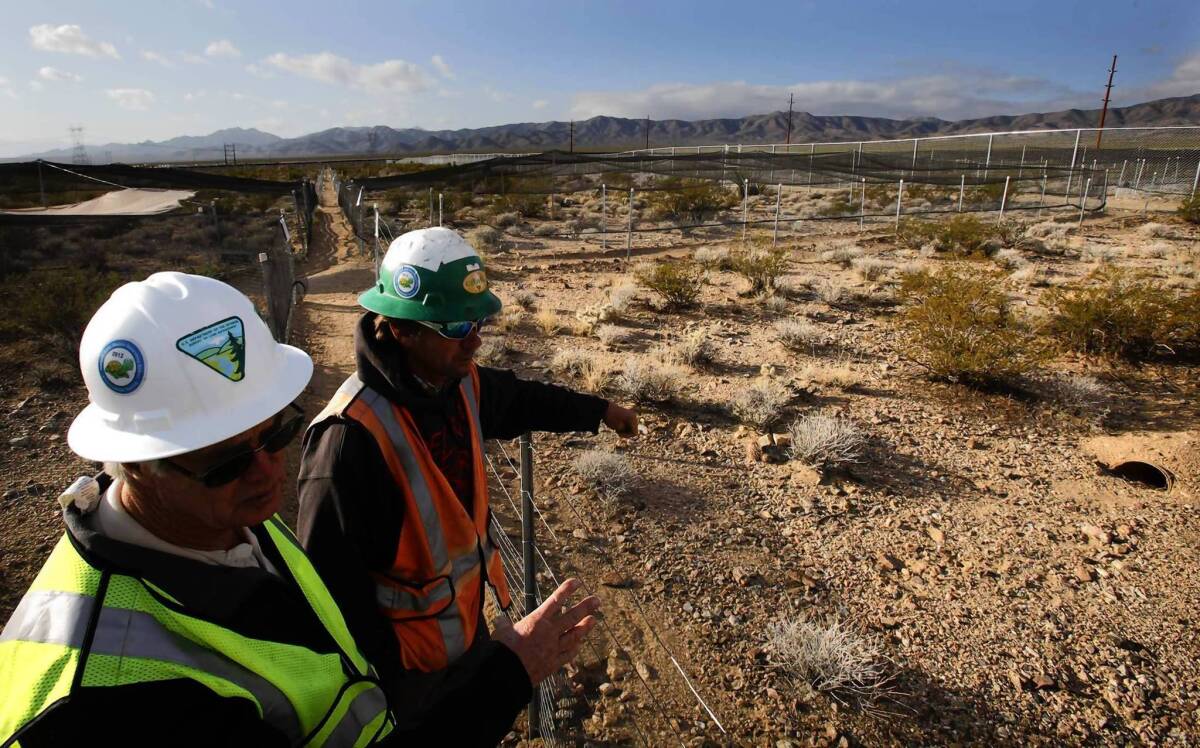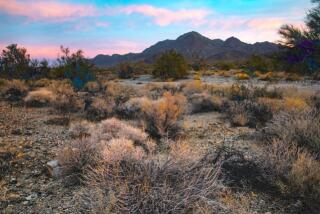U.S. solar plan creates energy zones, excludes sensitive lands

- Share via
The Obama administration unveiled plans Tuesday to ramp up solar energy production, offering incentives for solar developers to cluster projects on 285,000 acres of federal land in the western U.S and opening an additional 19 million acres of the Mojave Desert for new power plants.
The long-awaited plan also appears to rewind previous land-use decisions by the federal government. The pending policy rules out a long list of environmentally sensitive lands where the government — seeking to fast-track construction — had allowed solar development over the objections of environmentalists.
The plan places 445 square miles of public land in play for utility-scale solar facilities.
Interior Secretary Ken Salazar told reporters on a conference call that the country had no solar projects in the planning stages when Obama took office, contrasting the situation with the current rush to build plants.
“We have turned that around,” he said. “Three years later we stand at a proud moment in American history. It’s hard to overstate what a significant milestone this is for our administration.”
The plan establishes 17 solar energy zones in six Western states, including 154,000 acres in California. The zones were chosen because they avoided major environmental, cultural or other conflicts. The policy encourages developers to select sites within zones by promising minimal environmental reviews and expedited permitting.
In addition, the administration is completing work on a range of additional financial incentives, such as lower land lease payments and reduced costs of bonds.
The first-of-its-kind plan was hammered out over two years by an array of federal, state and local groups. The new rules include a list of areas where development is forbidden because of environmental or cultural sensitivity. On the exclusion list is the entire Ivanpah Valley, a biologically diverse swath of desert that straddles the California-Nevada border.
Conservation groups had fought to prevent approval of utility-scale projects in the region, contending that the desert — home to scores of endangered plants and animals — was not capable of absorbing industrial-scale change.
Despite opposition and an unexpectedly large population of federally protected desert tortoises, the Ivanpah Valley now has at least two large projects underway, including the world’s largest solar thermal power facility, being built by BrightSource Energy.
“We had to learn the hard way from BrightSource that it is a sensitive area,” said Ileene Anderson of the Center for Biological Diversity.
An alliance of environmental groups, utilities and solar companies praised the new plan, saying it provided the industry needed certainty and guidelines while preserving the Mojave’s most cherished places. The support is an about-face by developers, who had earlier opposed the zone approach as too restrictive.
Critics contend that the policies are too late, coming after years of free-for-all leasing that encouraged rampant speculation. Since leasing began, the Bureau of Land Management has been working to process more than 300 solar applications.
Many of those are for land in California’s Mojave Desert, where counties have seen the cost of private land soar and the desert given over to thousands of acres of mirrors. The state has 2 1/2 times more acreage in solar zones than other states.
While the zone concept is intended to guide development, it allows some flexibility for companies to construct plants on millions of acres included in designated “variance” zones. Developers may win approval to build in those areas but will have fewer government incentives to do so. California has three-quarters of a million acres in variance areas.
The fast-tracking of solar facilities on public lands is expected to generate nearly 24,000 megawatts of power by 2030, according to Mike Pool, acting director of the Bureau of Land Management.
But so far, the unprecedented urgency given to solar energy projects on public land has yielded only 50 megawatts, said Interior official Steve Black.
The plan will be finalized after a 30-day comment period. Officials said that whatever rules are eventually adopted will apply only to new projects and not the 17 solar facilities already awarded permits or the 78 currently in the approval pipeline.
More to Read
Inside the business of entertainment
The Wide Shot brings you news, analysis and insights on everything from streaming wars to production — and what it all means for the future.
You may occasionally receive promotional content from the Los Angeles Times.










